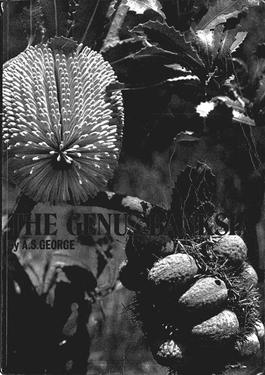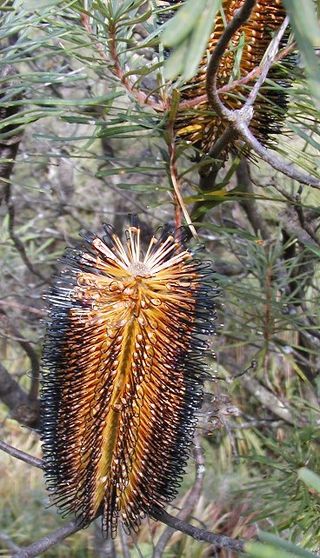
Banksia subg. Banksia is a valid botanic name for a subgenus of Banksia. As an autonym, it necessarily contains the type species of Banksia, B. serrata. Within this constraint, however, there have been various circumscriptions.

Banksia petiolaris is a rare species of flowering plant in the family Proteaceae native to Western Australia, where it is found in sandy soils in the south coastal regions from Munglinup east to Israelite Bay. It was first described by Victorian state botanist Ferdinand von Mueller in 1864, and no subspecies are recognised. B. petiolaris is one of several closely related species that will all grow as prostrate shrubs, with horizontal stems and thick, leathery upright leaves. Those of this species can be viable for up to 13 years—the longest-lived of any flowering plant recorded. It bears yellow cylindrical flower spikes, known as inflorescences, up to 16 cm high in spring. As the spikes age, they turn grey and develop up to 20 woody seed pods, known as follicles, each.

Banksia gardneri, commonly known as prostrate banksia, is a species of prostrate shrub that is endemic to Western Australia. It has pinnatipartite or serrated leaves, usually rusty brown flowers, and up to twenty-five elliptical follicles in each fruiting head. It occurs along the west part of the south coast of the state.

Banksia repens, the creeping banksia, is a species of shrub in the plant genus Banksia. It occurs on the south coast of Western Australia from D'Entrecasteaux National Park in the west to Mount Ragged in the east.

Banksia blechnifolia is a species of flowering plant in the genus Banksia found in Western Australia. It was first described by Victorian state botanist Ferdinand von Mueller in 1864, and no subspecies are recognised. It gained its specific name as its leaves are reminiscent of a fern (Blechnum). B. blechnifolia is one of several closely related species that grow as prostrate shrubs, with horizontal stems and leathery, upright leaves. The red-brown flower spikes, known as inflorescences, are up to 20 centimetres (8 in) high and appear from September to November in the Australian spring. As the spikes age, each turns grey and develops as many as 25 woody seed pods, known as follicles.

"The genus Banksia L.f. (Proteaceae)" is a 1981 monograph by Alex George on the taxonomy of the plant genus Banksia. Published by the Western Australian Herbarium as Nuytsia3(3), it presented George's taxonomic arrangement of Banksia, the first major taxonomic revision of the genus since George Bentham published his arrangement in Flora Australiensis in 1870.
Kevin Thiele and Pauline Ladiges taxonomic arrangement of Banksia, published in 1996, was a novel taxonomic arrangement that was intended to align the taxonomy of Banksia more closely with the phylogeny that they had inferred from their cladistic analysis of the genus. It replaced Alex George's 1981 arrangement, but most aspects were not accepted by George, and it was soon replaced by a 1999 revision of George's arrangement. However some herbaria have continued to follow Thiele and Ladiges on some points.

Alex George's taxonomic arrangement of Banksia was the first modern-day arrangement for that genus. First published in 1981 in the classic monograph The genus Banksia L.f. (Proteaceae), it superseded the arrangement of George Bentham, which had stood for over a hundred years. It was overturned in 1996 by Kevin Thiele and Pauline Ladiges, but restored by George in 1999. A recent publication by Austin Mast and Kevin Thiele suggests that it will soon be overturned again.

Banksia spinulosa var. cunninghamii, sometimes given species rank as Banksia cunninghamii, is a shrub that grows along the east coast of Australia, in Victoria and New South Wales. It is a fast-growing non-lignotuberous shrub or small tree infrequently cultivated.
Banksia undata var. splendens is a shrub endemic to Western Australia.

Banksia sessilis var. cordata is a variety of Banksia sessilis, with unusually large leaves and flower heads. It is a rare variety that is restricted to the extreme south-west corner of Western Australia.
Banksia gardneri var. gardneri is a variety of Banksia gardneri. As an autonym, it is defined as encompassing the type material of the species. It is native to the Southwest Botanical Province of Western Australia.
Banksia gardneri var. hiemalis is a variety of Banksia gardneri. It is native to the Southwest Botanical Province of Western Australia. Seeds do not require any treatment, and take around 19 days to germinate.
Banksia leptophylla var. melletica is a variety of Banksia leptophylla. It is native to the Southwest Botanical Province of Western Australia.
Banksia nutans var. cernuella is a variety of Banksia nutans. It is native to the Southwest Botanical Province of Western Australia. Seeds do not require any treatment, and take around 17 days to germinate.

Banksia sphaerocarpa var. dolichostyla, commonly known as Ironcap Banksia, is a plant which is either considered a variety of Banksia sphaerocarpa, or as a species in its own right. It is native to the Southwest Botanical Province of Western Australia. Seeds do not require any treatment, and take around 33 days to germinate.
Banksia densa var. parva is a variety of Banksia densa. It was known as Dryandra conferta var. parva until 2007, when Austin Mast and Kevin Thiele sunk all Dryandra into Banksia. Since there was already a Banksia named Banksia conferta, Mast and Thiele had to choose a new specific epithet for D. conferta and hence for this variety of it. As with other members of Banksia ser. Dryandra, it is endemic to the South West Botanical Province of Western Australia.
Banksia tenuis var. reptans is a variety of Banksia tenuis. It was known as Dryandra tenuifolia var. reptans until 2007, when Austin Mast and Kevin Thiele sunk all Dryandra into Banksia. Since the name Banksia tenuifolia had already been used, Mast and Thiele had to choose a new specific epithet for D. tenuifolia and hence for this variety of it. As with other members of Banksia ser. Dryandra, it is endemic to the South West Botanical Province of Western Australia.
Banksia leptophylla var. leptophylla is a variety of Banksia leptophylla. It is native to the Southwest Botanical Province of Western Australia. As an autonym, it is defined as containing the type specimen of the species.
Banksia nutans var. nutans is a variety of the plant Banksia nutans. It is native to the Southwest Botanical Province of Western Australia. As an autonym, its name is defined as containing the type specimen of the species.










